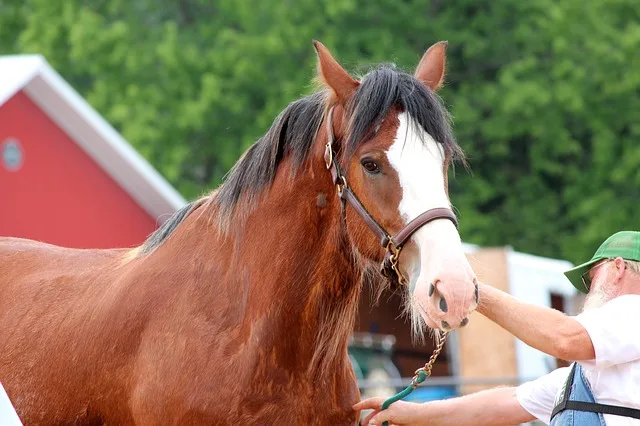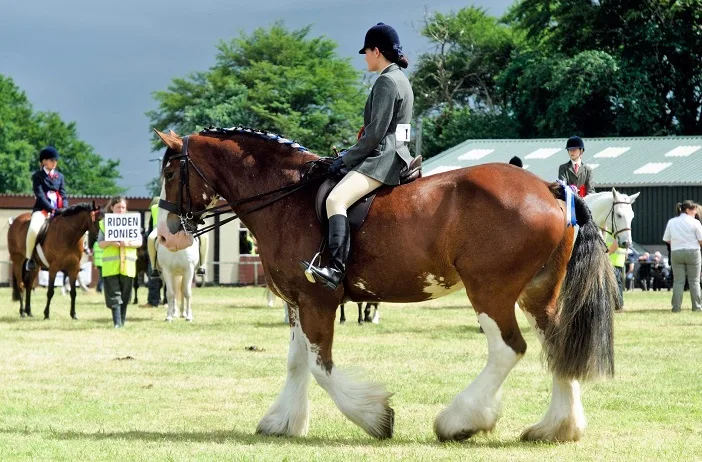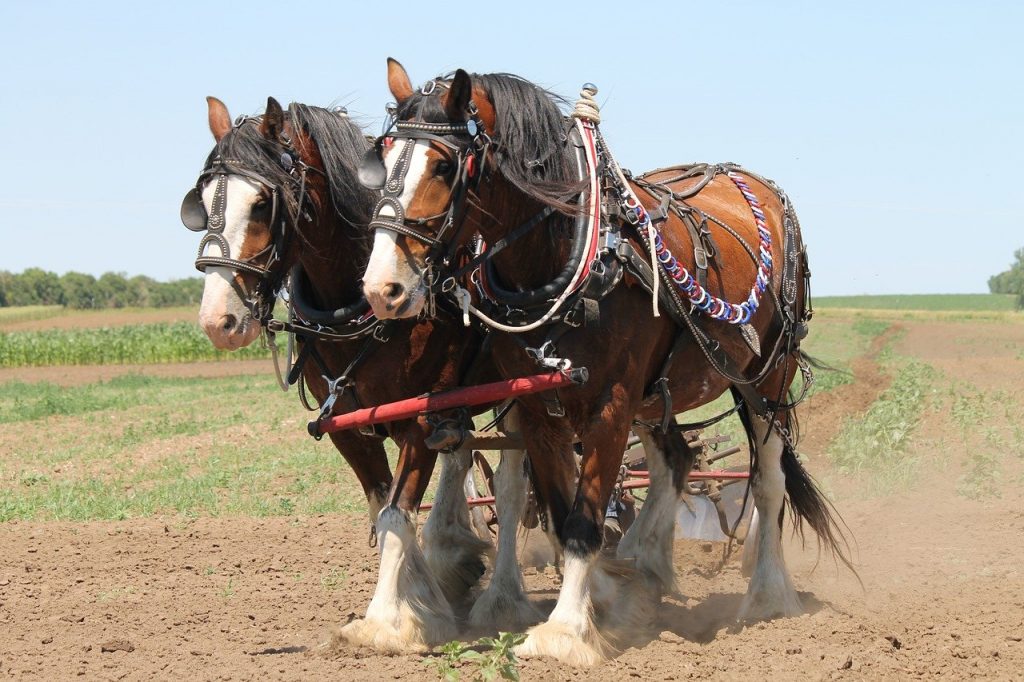Who wouldn’t know the dashing Clydesdales of Budweiser commercials? This unique breed originates from the valley of the River Clyde in Scotland. Around the 18th century, Flemish stallions were crossed with local heavy mares to create the breed’s foundation stock.
A typical Clydesdale is bay with a white blaze, four white stockings, and heavy feathering on the legs. Traditionally, they have worked in agriculture and transported heavy goods.
Today, Clydesdales are used for both riding and driving, and also for publicity. What’s more, they contributed to the development of other horse breeds, such as the Gypsy Vanner.
Here are 7 facts you didn’t know about Clydesdale horses!
Clydesdales are some of the largest and heaviest horses in the world
Clydesdales are one of the biggest horse breeds measuring 16 to 18 hands in height and weighing on average 1,800 pounds (816 kg). Clydesdales weighing over a ton is not a rarity either.
A prime example of how large Clydesdales can grow is a horse named Po from Ontario, Canada. According to Karina Brez, Po stands 20.2 hands tall and weighs an incredible 3,000 pounds (1,361 kg)!
The measurements of this enormous Clydesdale are not far off from the Guinness World Record for the tallest and heaviest horse ever lived. Included in our tallest horses ever guide, the record is currently held by a Shire horse called Sampson, who stood at 21.2 and a half hands tall and weighed 3,359 pounds (1,524 kg).

Clydesdales already show their potential to grow big at birth. While an average newborn foal will weigh around 100 pounds (45 kg), Clydesdales typically weigh 180 pounds (81.7 kg) at birth. What’s more, a Clydesdale mare can produce up to 11 gallons (43 liters) a day to feed her foal (Source: Karina Brez).
Clydesdales serve in the British Household Cavalry as drum horses
Clydesdales and Shires have traditionally been used in the Household Cavalry as drum horses. They are usually the largest of all cavalry horses and can be spotted from far away on parades and official ceremonies.
Drum horses are often colored or roan and must be at least 17 hands (173 cm) at the withers. Clydesdales are ideal for this role given their large and powerful build, as they have to carry the Musical Ride Officer and two silver drums on either side, weighing 60lbs (25kgs) each.
The cavalry normally buys in new drum horses as 4 or 5-year-olds and trains them for 2 years. It’s very important that these horses have a quiet temperament and are confident enough to lead a parade.
Drum horses must learn to respond to “foot reins”, which is how the drummer retains control while playing the drums at the same time. These special reins run from the horse’s bit to the drummer’s stirrups, providing a convenient means of steering.
Clydesdales are a rare horse breed
Once upon a time, there were tens of thousands of Clydesdales roaming around the world. However, following the First World War and the mechanization of agriculture, their numbers declined drastically. Today, only a few thousand Clydesdales remain, mostly in the United States, Canada, Australia, and the United Kingdom.

Photo by Iain Smith (Flickr)
In 2020, the Domestic Animal Diversity Information System (DAD-IS) has marked the breed “at risk” worldwide. In the same year, the Rare Breeds Survival Trust (RBST) declared the Clydesdale vulnerable to extinction in the United Kingdom. This means that fewer than 900 Clydesdale broodmares remain in the breed’s home country.
While their numbers are stable today, Clydesdales have come close to extinction several times in the past. According to Karina Brez, no more than 80 registered Clydesdales existed in the year 1975 worldwide. Luckily, that number has since risen to over 5,000, with around 600 Clydesdales being registered in the US alone each year.
The breed’s impressive comeback was partly due to the Anheuser Bush company featuring Clydesdales in their Budweiser commercials. The charming TV adverts showed off the breed’s elegance, beauty and kind nature, popularizing these gentle giants once again.
The hooves of Clydesdales are the size of a dinner plate
Giant horses need proportionately giant feet to spread their weight on a wider surface. The large hooves of Clydesdales provide the necessary foundation and support to their bodies in order to avoid diseases like navicular.
Contrary to other draft breeds, Clydesdales were purposely bred to have particularly wide feet. This trait served as an advantage in the wet Clyde Valley, where horses had to work on soft farmlands all year round. The excellent shock-absorbing ability of such large hooves also makes Clydesdales ideal for pulling a carriage or parading in the city.
Shoeing these horses is no average task either. A single horseshoe for an adult Clydesdale weighs around 5 pounds (2.27 kg), which is four times heavier than a racehorse’s shoe.

OlesyaNickolaeva/Shutterstock.com
In addition, Clydesdales shown in conformation classes usually wear a “Scotch Bottom” shoe. This special shoe makes their hooves look even wider and causes them to exhibit a high stepping gait. These traits are desirable in hitch and halter type horses.
The heavy feathering of Clydesdales was developed to protect them from the Scottish winter
Feathering refers to the long hair covering the hooves and ankles of a horse. It is characteristic of many draft and pony breeds, while warmbloods usually have very thin feathers or none at all.
Clydesdales have always been renowned for their silky, long feathers. It is thought that Shire blood was used to thicken the Clydesdale’s feathering in order to protect the horses’ feet from the harsh Scottish winter (Source: Karina Brez).
Although feathers give the breed an attractive look, they can also cause a number of health issues. It takes thorough daily care and regular conditioning to keep a Clydesdale’s feathers white and silky. If the horses are left out on a wet and muddy field for too long, accumulated dirt in the feathers can cause painful scratching in the fetlock area.
Also read: 7 Horse Breeds with Long Hair & Feathered Feet
Clydesdes have incredible pulling power
Besides being gentle and beautiful, Clydesdales are also very strong. A Clydesdale can pull up to 8,000 pounds (over 3.5 tons) for a short period of time. They also have no problem plodding along with a 400 pound (181 kg) carriage behind them all day long.
Their jaw-dropping pulling power is why Clydesdales have been used by farmers for centuries. When it comes to raw muscle strength, only the strongest horse breeds can compete with them. The world record for pulling is currently held by a pair of Belgian Drafts that pulled 22,000 pounds (close to 10 tons) over 66 inches (1.7 m) of dry clay.
Draft horses can show off their incredible strength on dedicated pulling competitions. They train for several years before being able to qualify for a draft competition. The horses usually compete by size and in pairs, pulling a stack of concrete blocks on a sled.

Also, read our guide on how much weight a horse can pull.
An average Clydesdale eats twice as much as a regular horse
As a rule of thumb, horses should consume 1.5-2% of their body weight in feed per day. The majority of their diet must consist of high fiber feeds such as grass or hay, with a small amount of concentrate feed on the side.
Given their above-average size, Clydesdales are naturally big eaters. An average adult will consume 25-40 pounds (11-18 kg) of hay per day, which is nearly half of a small square hay bale. Most Clydesdales will also be fed 2-10 pounds (0.9-4.5 kg) of concentrate feed, split into two or three meals per day.
On the other hand, performance Clydesdales will eat even more. The horses of Budweiser are fed 50-60 pounds of hay a day (around 25 kg) and nearly as much concentrate.
If you’re considering buying a Clydesdale, you need to factor in their enormous feed and space requirements. You must also provide fresh water at all times, as a fully grown adult will drink 30 gallons (114 liters) of water a day.
Source: horseyhooves.com





